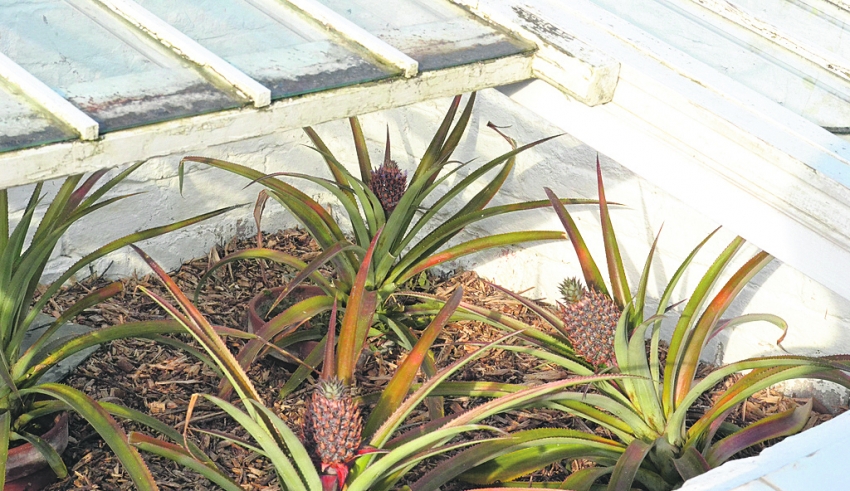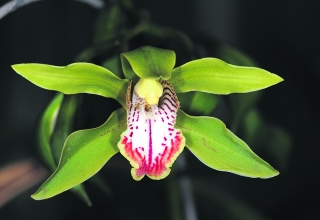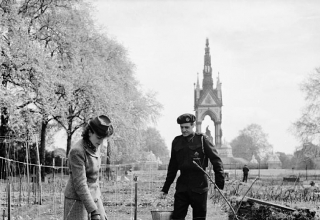
by Vivienne Lewis
How exotic the first pineapples must have looked to people in Britain when they first arrived here in the 1600s – and how did gardeners manage to grow them?
The arrival of pineapples in this country was such an event that they were presented to the monarch – an oil painting shows the gardener to King Charles II, John Rose, thought to be the figure pictured in the formal garden of a grand country house (possibly Dorney Court near Windsor) and kneeling before the fashionably dressed King, proffering the exotic fruit to him.
It could have been an imported fruit although it was supposed to be the first pineapple grown in England (the painting dates from 1675-80). Historians have pointed out earlier references to the fruit in writings by 17th gardeners including John Parkinson and John Evelyn. But whatever its origins in this country the pineapple was soon established as the most prestigious fruit of all and soon gardeners were trying to find ways of growing it.
It became a symbol of health and prosperity, so much so that it was used in stonework on grand gate piers, and interior decoration – and even a huge version as a summer house on the Dunmore estate in Scotland (now rented out for holiday accommodation).
The pineapple originated in Brazil in South America and on their voyage to the West Indies Christopher Columbus and his crew members were probably the first few people from the European continent to have tasted the fruit.
The word pineapple in English was first recorded in 1398, when it was originally used to describe the reproductive organs of conifer trees (now termed pine cones). When European explorers discovered the tropical fruit they called them pineapples (the term first recorded in that sense in 1664) because of their resemblance to the pine cone.
Pineapples were grown in Barbados, then the richest British colony, and there were many reports by travellers of seeing them grow. There are also stories of the fruit rotting en route to London, so to see them was special. It was another thing to get them to flourish in Britain.

In the 1680s the Dutch developed a hothouse suitable for growing pineapples and in 1689 when William of Orange acceded to the throne similar stoves were built at Hampton Court. The innovation was to create narrow sloping glass walls which were heated and ventilated; they measured 2.4m (8 ft) front to back to ensure the maximum amount of light to help the plants grow.
Soon gardeners on grand estates had access to written instructions on growing pineapples, in Richard Bradley’s A General Treatise of Husbandry and Gardening of 1721. They take three years to flower, and produce only one large plant with some smaller ones on each plant. That must have been disappointing.
By the 18th century pineapples were considered a necessary fashionable decoration for gatherings and parties, and some were bought or even hired, so desperate were hosts to have them on display. Large hothouses known as pineries were built in the kitchen gardens of great houses to meet the demand of owners and guests.
By the Victorian period glasshouses were becoming more affordable and amateur gardeners tried growing the fruit. In her book The Victorian Gardener, author Anne Wilkinson tells of an article published in Floral World in 1868 of a gardener growing pineapples in a pine pit that covered 500 square feet divided into three sections: a first pit, a succession pit and a fruiting pit.

There were 136 plants of which 42 were showing signs of fruiting, and it was expected that at least 50 fruits of three and a half to four pounds each would be produced that year. The average outlay for maintaining the pine house was just over £27 for coke, tan, soil, sand, rotten dung, pots, and general maintenance – painting and repairs. Also, the cost of labour of two hours a day throughout the year was at least £15. Total: £42 in Victorian times, a huge sum to grow plants.
Although the writer pointed out that it would be possible to grow pineapples on a smaller scale it would still need a paid gardener to look after the plants constantly. No wonder they were mostly cultivated by the rich on their estates.
The Lost Gardens of Heligan and the restored pineapple pits
The Victorian method of growing pineapples had been lost but thanks to the restoration of the gardens on the Heligan estate near St Austell in Cornwall we know a lot more. The art of pit management was lost and in the absence of any written instructions, the staff had to learn through trial and error.
They found that temperature control and humidity are all important and the plants must not be over watered. Frequent changes of fresh horse manure are essential to keep up the temperature during cold periods and emptying and re-filling the trenches, either side of the pit, are tough and unpleasant manual tasks.
These trenches are covered with boarding to maximise the delivery of heat into the pit itself, through holes in their double-skinned walls. They have also realised that as the days of horse-power have long passed it’s increasingly difficult to source the quality, and expensive to transport the amount needed of freshly rotting horse manure required for a whole winter’s heating.
It has been quite a learning curve for the staff at Heligan. The current variegated variety when ready to harvest took five years before it even began to fruit, then another two to grow the fruit. With the hours it has taken to look after the pineapple, transport costs of manure, maintenance of the pineapple pits and other tasks, each pineapple would probably cost more than £1,000 to grow.
Although pineapple pits are heated by fresh horse manure but the pineapples themselves do not come into contact with any manure or urine at any stage. Manure is loaded into manure trenches behind and in front of the pit itself. The heat generated from the manure travels through the hollow walls and through the bark beneath the potted plants to recreate a tropical environment for them to grow in.
So this is a valuable exercise in learning just how the Victorians grew the exotic fruit and after restoring the pits at Heligan, keeping them in use is rewarding for the staff and for the visitors. Any pineapples that grow are given to members of staff as a thank you for their hard work.
Want to try yourself? Patience is the thing
If you are thinking you might try to emulate the successes of Victorian gardeners in growing pineapples yourself then be warned.
It isn’t easy and you’ll need a lot of patience.
Pineapple plants need it hot, must never get chilled and need two or three years to crop. If you’d like to try then choose a healthy crowned pineapple, cut off the crown immediately above the fruit and let it dry for several days. Peel away the lower decaying leaves and you should see the first roots appearing. Pot up in a bucket sized pot of rich well-drained compost and find the warmest sunniest position you can. Keep the centre dry and warm in winter – and then wait. Good luck!










